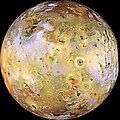File:Iosurface gal.jpg
- Fichier
- Historique du fichier
- Utilisations locales du fichier
- Utilisations du fichier sur d’autres wikis

Fichier d’origine (1 817 × 1 817 pixels, taille du fichier : 391 kio, type MIME : image/jpeg)
Légendes
Légendes
|
Original Caption Released with Image: Io, the most volcanic body in the solar system is seen in the highest resolution obtained to date by NASA's Galileo spacecraft. The smallest features that can be discerned are 2.5 kilometers in size. There are rugged mountains several kilometers high, layered materials forming plateaus, and many irregular depressions called volcanic calderas. Several of the dark, flow-like features correspond to hot spots, and may be active lava flows. There are no landforms resembling impact craters, as the volcanism covers the surface with new deposits much more rapidly than the flux of comets and asteroids can create large impact craters. The picture is centered on the side of Io that always faces away from Jupiter; north is to the top.
Color images acquired on September 7, 1996 have been merged with higher resolution images acquired on November 6, 1996 by the Solid State Imaging (CCD) system aboard NASA's Galileo spacecraft. The color is composed of data taken, at a range of 487,000 kilometers, in the near-infrared, green, and violet filters and has been enhanced to emphasize the extraordinary variations in color and brightness that characterize Io's face. The high resolution images were obtained at ranges which varied from 245,719 kilometers to 403,100 kilometers.
Launched in October 1989, Galileo entered orbit around Jupiter on December 7, 1995. The spacecraft's mission is to conduct detailed studies of the giant planet, its largest moons and the Jovian magnetic environment. The Jet Propulsion Laboratory, Pasadena, CA manages the mission for NASA's Office of Space Science, Washington, DC.
Source: http://photojournal.jpl.nasa.gov/catalog/PIA00583 ; English Wikipedia, original upload 24 April 2003 by JeLuF
| Public domainPublic domainfalsefalse |
| Ce fichier provient de la NASA. Sauf exception, les documents créés par la NASA ne sont pas soumis à copyright. Pour plus d'informations, voir la politique de copyright de la NASA. |  | |
 |
Attention :
|
Historique du fichier
Cliquer sur une date et heure pour voir le fichier tel qu'il était à ce moment-là.
| Date et heure | Vignette | Dimensions | Utilisateur | Commentaire | |
|---|---|---|---|---|---|
| actuel | 22 mai 2009 à 17:43 |  | 1 817 × 1 817 (391 kio) | Mahahahaneapneap (d | contributions) | Higher resolution - from same source. |
| 16 septembre 2005 à 10:04 |  | 908 × 908 (123 kio) | Saperaud~commonswiki (d | contributions) | '''Original Caption Released with Image''': Io, the most volcanic body in the solar system is seen in the highest resolution obtained to date by NASA's Galileo spacecraft. The smallest features that can be discerned are 2.5 kilometers in size. There are |
Vous ne pouvez pas remplacer ce fichier.
Utilisations locales du fichier
Les 2 pages suivantes utilisent ce fichier :
- Io
- File:250px -Iosurface gal.jpg (redirection de fichier)
Utilisations du fichier sur d’autres wikis
Les autres wikis suivants utilisent ce fichier :
- Utilisation sur bg.wikipedia.org
- Utilisation sur br.wikipedia.org
- Utilisation sur de.wikipedia.org
- Utilisation sur en.wikipedia.org
- Wikipedia:Today's featured article/October 2004
- Wikipedia:Today's featured article/October 9, 2004
- Template:Pic of the day/Archive1
- Wikipedia:Featured picture candidates/April-2004
- Wikipedia:Picture of the day/December 2004
- Wikipedia:POTD/December 16, 2004
- Wikipedia:Picture of the day/December 16, 2004
- Wikipedia:Picture of the day/May 2004
- Portal:Astronomy/Picture/May 2005
- Portal:Astronomy/Picture/20 May 2005
- Portal:Astronomy/Picture/Week 04 2006
- User:Cyde/Featured pictures
- User:Oryanw~enwiki
- Portal:Outer space/Featured
- Portal:Outer space/Featured/Picture
- Wikipedia:WikiProject Astronomy/Recognized content
- Portal:Volcanoes/Selected picture
- The Very Pulse of the Machine
- Portal:Volcanoes/Selected picture/6
- Wikipedia talk:WikiProject Solar System/Archive 1
- User:Aladdin Sane/B5-AS-notes/List of locations in Babylon 5 (sandbox)
- Wikipedia:WikiProject Volcanoes/Content
- Wikipedia:Featured picture candidates/delist/2010
- Exploration of Io
- Wikipedia:Featured picture candidates/Io moon
- Wikipedia:WikiProject Astronomy/Recognized astronomy content
- Chaac-Camaxtli region
- Template:POTD/2004-05-24
- Utilisation sur en.wikiversity.org
- User:Marshallsumter/Radiation astronomy2/Yellows
- User:Marshallsumter/Radiation astronomy2/Violets
- Solar System, technical/Io
- Draft:Original research/Io
- User:Marshallsumter/Radiation astronomy2/Violets/Quiz
- Stars/Sun/Astronomy/Quiz
- User:Marshallsumter/Rocks/Rocky objects/Astronomy
- Object astronomy
- User:Marshallsumter/Radiation astronomy/Courses/Principles/Hourly 2
- User:Marshallsumter/Original research/Volcanoes
- User:Marshallsumter/Radiation astronomy/Courses/Principles/Final quiz
- Draft:Original research/Io/Quiz
- Titan/Quiz
- Stars/Solar systems/Quiz
- User:Marshallsumter/Rocks/Rocky objects
- Volcanoes/Io
- Moon/Quiz
- Earth/Quiz
Voir davantage sur l’utilisation globale de ce fichier.